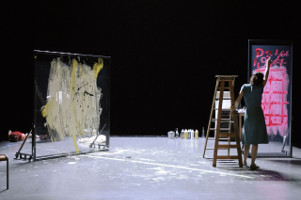|
"Pollock" by Fabrice
Melquiot
"Pollock"
By Fabrice Melquiot, directed by Paul Desveaux
Underground Theatre at the Henry Treet Settlement, Abrons Art Center,
466 Grand St., NYC
Produced by Compagnie L'Heliotrope, co-presented with the
Cultural Services of the French Embassy in New York
February 15 - 25, 2018
Tuesdays - Saturdays at 7:30 pm, Sundays at 3:30 pm
Tickets: (866) 811-4111
 |
| Photo
courtesy of Underground Theatre. |
Jackson Pollock was a major twentieth-century
innovator, whose iconoclastic paintings helped to shift the center
of modern art from the post-Impressionist France of Picasso and Matisse
to the Abstract Impressionism of the United States. His life is a
legend, the tormented genius, the out-of control alcoholic who died
in a tragic car accident at the age of 44, but who was loved by Lee
Krasner, a major artist, and Peggy Guggenheim, his patron.
Playwright Fabrice Melquiot has done extensive, impressive research
on the artist. His two-hander "Pollock," one of a trilogy
of tormented artists that includes Janis Joplin and Diane Arbus, is
currently at the Underground Theatre on Grand St. It was produced
by Compagnie L'Héliotrope and the Cultural Services of the
French Embassy in New York. It should be better than it is.
In a talk-back after the show, Melquiot and director Paul Desveaux
described the work as impressionistic rather than biographical. But
even impressionist work needs dramatic structure, revelations, discoveries,
reversals, and maybe even a dénouement – some reason
for the audience to sit and watch. It's obvious from the first 20
minutes that Pollock is a moody, abusive alcoholic and perhaps, at
least according to his wife, a genius. "[Genius is] on your face
on every single one of your paintings," she says, "poor
love my poor love and as your face helps you see where to put your
feet like the paintings help you stand up straight."
The staging by Paul Desveaux is fluid. Two microphones
flank the stage. Most of the play is set in Pollock's studio(s) so
there is the paraphernalia of paint cans, brushes, etc. A large cloth
covers the floor. It is an open space that invites the viewer in.
There are some lovely moments. Jackson delicately walks around an
imaginary canvas on the floor and drips out a spidery dance in black
paint. Lee is furious that he stayed out all night with Tennessee
Williams when they are on Cape Cod, and that Williams later made himself
their guest. Lee and Jackson wrestle on the floor in anger. Jackson
rips through paintings with a palette knife. There is some interesting
discussion of Jackson's fractal patterns – scientific studies
of the artist's intuitive understanding which density would create
the best art. He destroyed the paintings in which the algorithm failed.
And there are moments that seem to offer no insight into the painters
or their relationship. We see him throw yellow paint at the large
plastic "canvases" hung vertically and wipe paint on Lee's
face. Lee wipes paint on him. (I kept wishing for that wonderful moment
in "Red" by John Logan when painter Rothko and his assistant
prepped a large canvas in a seemingly choreographed dance.) While
he is throwing tantrums or verbally abusing her, Lee smiles sweetly
and offers him eggs. She is a caricature of the good little wife.
There is no chronology, which can be a great advantage in plays like
Paula Vogel's "How I Learned to Drive." Here it is disorienting.
Although predictable, the role of Pollock had some nuance and mood.
It offered actor Jim Fletcher an interesting range, and he ran through
the emotions well. Good timing. But Birgit Huppuch as Lee had so little
subtext and action that she was almost part of the set. The playwright
and director claimed the play was as much about her as about Jackson,
but Lee Krasner, whose work ranged from the dense, Klee-like Little
Images to the large, highly expressive later painting, was simply
a foil. |


